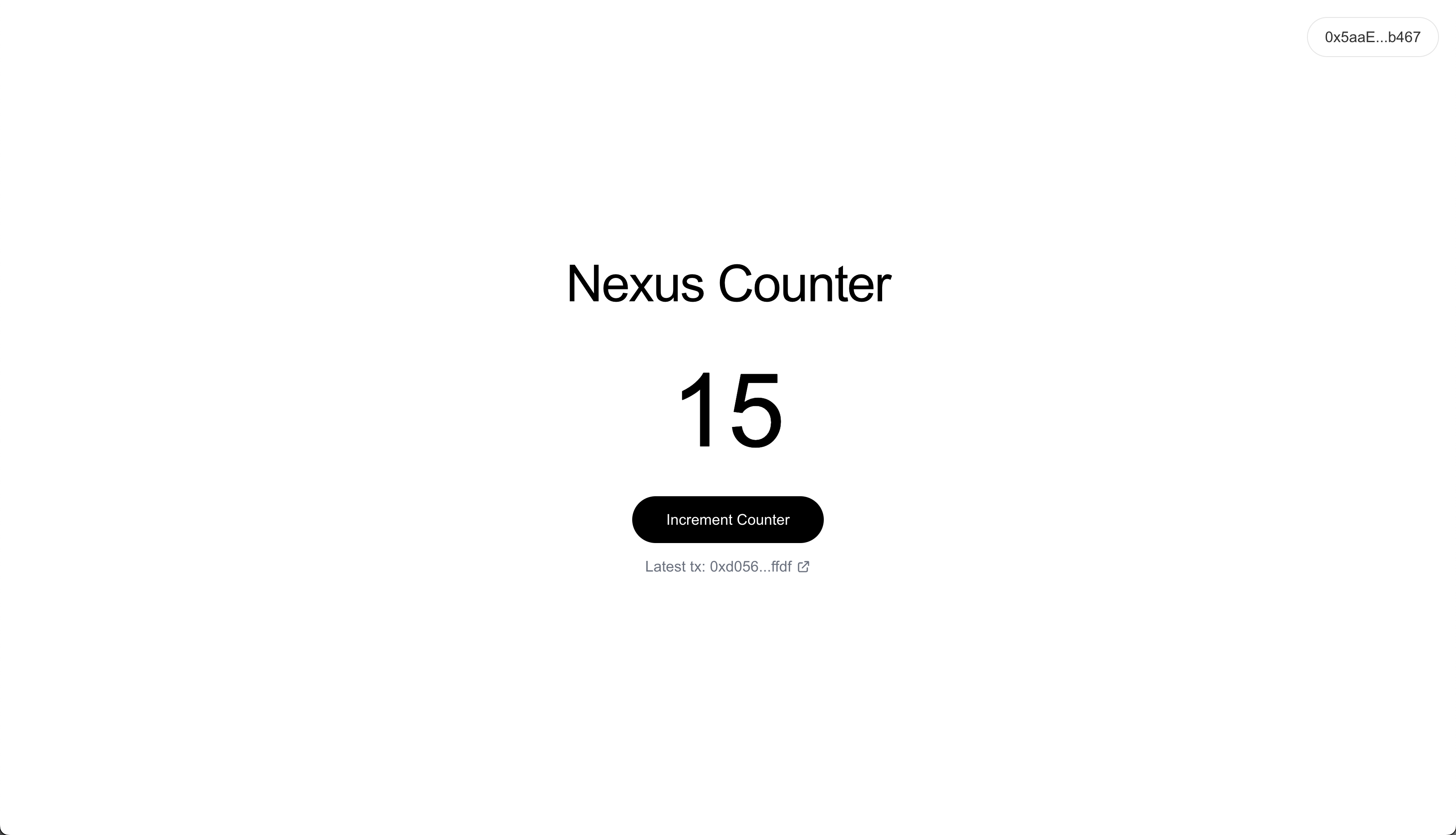'use client'
import { useState, useEffect, useCallback } from 'react'
import { BrowserProvider, JsonRpcSigner, Contract } from 'ethers'
const CONTRACT_ADDRESS = 'enter your deployed contract address'
const CONTRACT_ABI = [
"function increment() public",
"function getCount() public view returns (uint256)"
]
const NEXUS_CHAIN_ID = '0x3940'
const NEXUS_RPC_URL = "https://testnet3.rpc.nexus.xyz"
const EXPLORER_URL = 'https://testnet3.explorer.nexus.xyz'
export default function Home() {
const [count, setCount] = useState<number>(0)
const [isConnected, setIsConnected] = useState(false)
const [isCorrectNetwork, setIsCorrectNetwork] = useState(false)
const [signer, setSigner] = useState<JsonRpcSigner | null>(null)
const [userAddress, setUserAddress] = useState<string>('')
const [lastTxHash, setLastTxHash] = useState<string>('')
useEffect(() => {
checkWalletConnection()
// Add network change listener
if (window.ethereum) {
window.ethereum.on('chainChanged', async () => {
const networkCorrect = await checkNetwork()
if (networkCorrect) {
const provider = new BrowserProvider(window.ethereum)
setSigner(await provider.getSigner())
await getCount()
}
})
}
// Cleanup listener
return () => {
if (window.ethereum) {
window.ethereum.removeListener('chainChanged', () => {
console.log('Network change listener removed')
})
}
}
}, [])
useEffect(() => {
if (signer) {
signer.getAddress().then(address => setUserAddress(address))
getCount() // Fetch count whenever signer changes
}
}, [signer])
const getCount = useCallback(async () => {
if (!signer) return
const contract = new Contract(CONTRACT_ADDRESS, CONTRACT_ABI, signer)
try {
const currentCount = await contract.getCount()
setCount(Number(currentCount))
} catch (error) {
console.error('Error getting count:', error)
}
}, [signer])
const checkNetwork = useCallback(async () => {
const chainId = await window.ethereum.request({ method: 'eth_chainId' })
setIsCorrectNetwork(chainId === NEXUS_CHAIN_ID)
return chainId === NEXUS_CHAIN_ID
}, [])
const switchNetwork = async () => {
try {
await window.ethereum.request({
method: 'wallet_switchEthereumChain',
params: [{ chainId: NEXUS_CHAIN_ID }],
})
const networkCorrect = await checkNetwork()
if (networkCorrect) {
const provider = new BrowserProvider(window.ethereum)
setSigner(await provider.getSigner())
await getCount()
}
return true
} catch (switchError: any) {
if (switchError.code === 4902) {
try {
await window.ethereum.request({
method: 'wallet_addEthereumChain',
params: [{
chainId: NEXUS_CHAIN_ID,
rpcUrls: [NEXUS_RPC_URL],
chainName: 'Nexus Testnet',
nativeCurrency: {
name: 'NEXUS',
symbol: 'NEXUS',
decimals: 18
},
}],
})
const networkCorrect = await checkNetwork()
if (networkCorrect) {
const provider = new BrowserProvider(window.ethereum)
setSigner(await provider.getSigner())
await getCount()
}
return true
} catch (addError) {
console.error('Error adding network:', addError)
return false
}
}
console.error('Error switching network:', switchError)
return false
}
}
const checkWalletConnection = useCallback(async () => {
if (typeof window.ethereum !== 'undefined') {
try {
const provider = new BrowserProvider(window.ethereum)
const accounts = await provider.listAccounts()
if (accounts.length > 0) {
const networkCorrect = await checkNetwork()
setIsConnected(true)
if (networkCorrect) {
setSigner(await provider.getSigner())
}
}
} catch (error) {
console.error('Error checking wallet connection:', error)
}
}
}, [checkNetwork])
const connectWallet = async () => {
if (typeof window.ethereum !== 'undefined') {
try {
const provider = new BrowserProvider(window.ethereum)
await provider.send('eth_requestAccounts', [])
const networkCorrect = await checkNetwork()
setIsConnected(true)
if (networkCorrect) {
setSigner(await provider.getSigner())
}
} catch (error) {
console.error('Error connecting wallet:', error)
}
}
}
const incrementCount = async () => {
if (!signer) return
const contract = new Contract(CONTRACT_ADDRESS, CONTRACT_ABI, signer)
try {
const tx = await contract.increment()
setLastTxHash(tx.hash)
await tx.wait()
await getCount()
} catch (error) {
console.error('Error incrementing count:', error)
}
}
const formatAddress = (address: string) => {
if (!address) return ''
return `${address.slice(0, 6)}...${address.slice(-4)}`
}
const formatHash = (hash: string) => {
if (!hash) return ''
return `${hash.slice(0, 6)}...${hash.slice(-4)}`
}
return (
<main className="min-h-screen bg-white relative">
<div className="absolute top-4 right-4 px-4 py-2 rounded-full border border-black/10">
<p className="text-sm font-medium text-black/80">
{isConnected ? formatAddress(userAddress) : 'Not Connected'}
</p>
</div>
<div className="flex items-center justify-center min-h-screen">
<div className="max-w-4xl w-full px-4">
<div className="space-y-12 text-center">
<h1 className="text-5xl font-light tracking-tight text-black">
Nexus Counter
</h1>
<div className="space-y-8">
{!isConnected ? (
<button
onClick={connectWallet}
className="px-8 py-3 text-sm font-medium text-white bg-black rounded-full
hover:bg-gray-800 transition-colors duration-200
focus:outline-none focus:ring-2 focus:ring-offset-2 focus:ring-black"
>
Connect Wallet
</button>
) : !isCorrectNetwork ? (
<button
onClick={switchNetwork}
className="px-8 py-3 text-sm font-medium text-black bg-transparent border-2 border-black rounded-full
hover:bg-black/10 transition-colors duration-200
focus:outline-none focus:ring-2 focus:ring-offset-2 focus:ring-black"
>
Switch to Nexus Network
</button>
) : (
<div className="space-y-8">
<div className="text-8xl font-light text-black">
{count}
</div>
<div className="flex flex-col items-center space-y-3">
<button
onClick={incrementCount}
className="px-8 py-3 text-sm font-medium text-white bg-black rounded-full
hover:bg-gray-800 transition-colors duration-200
focus:outline-none focus:ring-2 focus:ring-offset-2 focus:ring-black"
>
Increment Counter
</button>
{lastTxHash && (
<a
href={`${EXPLORER_URL}/tx/${lastTxHash}`}
target="_blank"
rel="noopener noreferrer"
className="inline-flex items-center text-sm text-gray-500 hover:text-gray-800
transition-colors duration-200"
aria-label={`View transaction ${formatHash(lastTxHash)} on Nexus Explorer`}
>
<span className="mr-1">Latest tx:</span>
<span className="font-medium">{formatHash(lastTxHash)}</span>
<svg
className="w-3.5 h-3.5 ml-1"
fill="none"
stroke="currentColor"
viewBox="0 0 24 24"
>
<path
strokeLinecap="round"
strokeLinejoin="round"
strokeWidth={2}
d="M10 6H6a2 2 0 00-2 2v10a2 2 0 002 2h10a2 2 0 002-2v-4M14 4h6m0 0v6m0-6L10 14"
/>
</svg>
</a>
)}
</div>
</div>
)}
</div>
</div>
</div>
</div>
</main>
)
}


